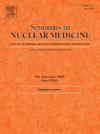FAPI PET in the Management of Lung Tumors
IF 5.9
2区 医学
Q1 RADIOLOGY, NUCLEAR MEDICINE & MEDICAL IMAGING
引用次数: 0
Abstract
Fibroblast activation protein (FAP), selectively expressed on activated fibroblasts in proliferating tissues, is emerging as a promising target in oncology. In lung cancer, the leading cause of cancer-related deaths worldwide, [18F]FDG PET/CT has set the bar high and earned widespread recognition in clinical guidelines for its essential role in staging and follow-up. Yet, FAP-targeted imaging agents like FAPI PET/CT have demonstrated significant potential due to their high tumor specificity, rapid tracer uptake, and low background activity. This review focuses on the role of FAPI PET/CT in lung cancer, highlighting its applications in staging, biomarker evaluation, and clinical management. FAP expression correlates with cancer associated fibroblast-driven tumorigenesis in lung cancer, showing higher expression in nonsmall cell lung cancer (NSCLC) than in small cell lung cancer (SCLC) subtypes. Studies reveal that FAPI PET/CT provides comparable or superior detection rates for primary tumors and metastases compared to [18F]FDG PET/CT, particularly in brain, pleural, and bone lesions. It also enhances accuracy in lymph node staging, influencing disease management by enabling surgical resection in cases misclassified by [18F]FDG PET/CT. Despite these advantages, several challenges remain, such as differentiating benign from malignant lesions, assessing FAPI's prognostic implications or its role in treatment response monitoring. Future directions include exploring FAPI-based theranostics, standardizing radiopharmaceuticals, and conducting well-designed, adequately powered prospective trials. FAPI PET/CT represents a transformative diagnostic tool, complementing or potentially surpassing [18F]FDG PET/CT in precision lung cancer care.
FAPI PET在肺部肿瘤治疗中的应用。
成纤维细胞活化蛋白(FAP)是一种选择性表达于增殖组织中活化的成纤维细胞上的蛋白,是肿瘤学研究中一个很有前景的靶点。肺癌是世界范围内癌症相关死亡的主要原因[18F], FDG PET/CT在分期和随访方面的重要作用已经树立了很高的标准,并在临床指南中得到了广泛的认可。然而,FAPI靶向显像剂,如FAPI PET/CT,由于其高肿瘤特异性、快速示踪剂摄取和低背景活性,已显示出巨大的潜力。本文综述了FAPI PET/CT在肺癌中的作用,重点介绍了其在分期、生物标志物评估和临床管理方面的应用。FAP表达与肺癌中成纤维细胞驱动的肿瘤发生相关,在非小细胞肺癌(NSCLC)中的表达高于在小细胞肺癌(SCLC)亚型中的表达。研究表明,与[18F]FDG PET/CT相比,FAPI PET/CT对原发肿瘤和转移瘤的检出率相当或更高,尤其是在脑、胸膜和骨病变方面。它还提高了淋巴结分期的准确性,通过在被FDG PET/CT错误分类的病例中进行手术切除来影响疾病的管理[18F]。尽管有这些优势,但仍存在一些挑战,例如区分良性和恶性病变,评估FAPI的预后意义或其在治疗反应监测中的作用。未来的方向包括探索基于fapi的治疗学,标准化放射性药物,以及进行精心设计,充分支持的前瞻性试验。FAPI PET/CT代表了一种变革性的诊断工具,补充或潜在地超越FDG PET/CT在肺癌精确治疗中的应用[18F]。
本文章由计算机程序翻译,如有差异,请以英文原文为准。
求助全文
约1分钟内获得全文
求助全文
来源期刊

Seminars in nuclear medicine
医学-核医学
CiteScore
9.80
自引率
6.10%
发文量
86
审稿时长
14 days
期刊介绍:
Seminars in Nuclear Medicine is the leading review journal in nuclear medicine. Each issue brings you expert reviews and commentary on a single topic as selected by the Editors. The journal contains extensive coverage of the field of nuclear medicine, including PET, SPECT, and other molecular imaging studies, and related imaging studies. Full-color illustrations are used throughout to highlight important findings. Seminars is included in PubMed/Medline, Thomson/ISI, and other major scientific indexes.
 求助内容:
求助内容: 应助结果提醒方式:
应助结果提醒方式:


